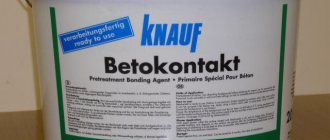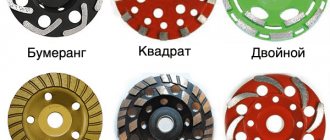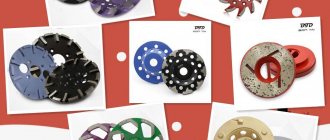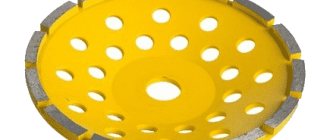A mosaic grinder for concrete is a special tool for processing stone or concrete floors. The equipment is used for grinding, polishing, eliminating sagging and potholes, and various surface defects. It is also relevant when it is necessary to level the old coating or remove the paint layer.
Thanks to the tool, you can quickly and effectively polish the surface to a mirror shine or roughen it, clean it using a brush attachment, and perform many other tasks. The use of grinders makes it possible to significantly reduce the time and labor costs for processing concrete, so the purchase of such equipment is economically justified.
Modern manufacturers offer a large selection of tool models for processing concrete and stone surfaces, which differ in power, functions, drive type, equipment, mobility and other parameters. Therefore, before purchasing equipment, you must carefully study all the characteristics and parameters.
Purpose
Mosaic grinding machines for concrete operate on a fairly simple principle: an engine powered by electricity or fuel transmits speed to the faceplates/traverses where the grinding tool (attachment) is installed.
The operator holds the machine in his hands or drives it in front of him (can sit in a special chair) and controls the equipment using a panel/joystick in front of him or on the handle. Control can also be remote, but this option is less common.
Therefore, usually the main criteria when choosing are the power and dimensions of the equipment, on which its cost directly depends.
Examples
A variety of types of tools can be used to process concrete and stone surfaces - Moscow and the regions offer a large selection of manufacturers, models from compact amateur to industrial special equipment.
Manual GM 122 Splitstone
This is a serial single-traverse model of a mosaic grinding machine, which is relevant for processing small areas limited by certain elements, layout, etc. The machine is maneuverable and operates on a 4 kW electric motor.
Manual GM 245 Splitstone
Productivity according to the passport is 100 (140) square meters per shift (under standard conditions). The unit weighs 175 kilograms including all equipment.
Self-propelled HTC 1500 IXT
The model is used for grinding any areas. It works silently and can process up to 30 square meters per shift. Captures a strip 145 centimeters wide, can maneuver and even turn 180 degrees.
Scope of application
- remove layers of old material;
- make the surface of the cemented floor smooth;
- get rid of bevels and bumps by smoothing them out;
- eliminate uneven concrete surfaces;
- impart roughness to the surface.
Kawabanga! The main thing you need to know when choosing a hacksaw for aerated concrete
Grinding is necessary to ensure that further coatings do not peel off during operation from the concrete surface under the influence of chemical, mechanical or vibration loads.
The process of grinding concrete is quite complex and time-consuming, but with the help of a grinder it becomes much easier.
Principle of operation
The equipment is activated through a control unit, to which the operator gives commands. The electric motor starts the rotation of the diamond segments. Special aprons, which are located in the front part of the frame, prevent the spread of small abrasive particles and dust. Some models provide for waste collection using an industrial vacuum cleaner connected to the machine with a pipe.
Advanced construction equipment designs operate in two modes—dry and wet. The second option is used for grinding the concrete mass. During this operation, water (emulsion, organic solvents) enters through a hose connected to the machine. The moisture supply is adjusted automatically in accordance with the specified program.
In addition, depending on the type of work, the operator controls the need for load on the diamond tool. For normal sanding this function is not necessary. And for abrasive surface treatment, special weights weighing from 7 to 10 kg are provided. Before starting work, the cutters are fixed in the desired position.
Design options
Based on the type of grinding equipment, machines can be classified into 5 lines: angular, belt, orbital (eccentric), vibrating and mosaic grinding. Each type of technology has its own characteristics and characteristics.
- As for mosaic grinding electric tools , they can work not only with any type of concrete, but also with marble. The range of options includes both rough preparatory treatment and fine work, for example, mirror polishing of the floor. These machines are equipped with discs to obtain rough surfaces with high adhesion to adhesives.
- Vibration-class equipment is purchased for pre-finishing processing of concrete and stone. The grinders in such equipment are abrasive sheets with different grain sizes, which are fixed on a special sole. This consumable often requires replacement, which is the main disadvantage of vibration grinding technology. The intensity of the action of the working element can change based on the amplitude of vibration oscillations.
Design
The basis of the machine is a supporting frame on which functional modules are fixed. The structure is easy to disassemble and assemble, making it easier to operate and repair. The operator interacts with the rear of the equipment, where the control levers are located.
An engine is installed in the central part of the frame, fixed with special brackets. If necessary, the position of the power unit can be changed by adjusting the tension belts.
In the front part of the frame there are functional units that are driven by engaging a V-belt drive (via a grinding crossbar).
For processing hard surfaces, a diamond tool is provided, consisting of segments of different shapes, degrees of abrasiveness and binder content. These elements are covered with a durable steel case, providing the device with reliable protection from damage.
In addition, the MSM is equipped with special cutters located in the lower part of the frame and fixed in a horizontal position. Using this tool, by adjusting its speed and direction of rotation, you can not only grind concrete, but also cut out mosaics (flat designs) on it.
How to use?
You can begin grinding work 2 or even 3 weeks after pouring the concrete. This time is enough for the foundation to gain strength.
The tool must be used strictly for its intended purpose. After work, it must be cleaned of dust and construction dirt, having first been disconnected from the power supply.
You cannot use the equipment without reading the instructions - this can lead to injury during operation.
If the switch is faulty, using the grinder is strictly prohibited. Do not store the product within the reach of household members and pets.
A review of the concrete grinding machine awaits you in the video below.
Grinding technology
Mosaic grinding machines are used to process durable concrete screeds made from mortar grades M150-M300, more than 3 centimeters high. The hillock/pit differences should not exceed 5 millimeters (otherwise the surface is first prepared for processing). Final grinding is carried out 30 days after the completion of the concrete pouring process.
Features of the concrete grinding process:
- It can be dry or wet - when wet, water is constantly supplied to the processing area, which allows you to remove dust, extend the service life of tools and equipment, and make the surface smoother. Dry grinding involves a lot of dust, but the operator immediately sees the quality of the work and can correct something.
- Dust is removed with a vacuum cleaner.
- The number of grinding operations can be 3-15 cycles, depending on the requirements for the final result. Abrasives of various grit levels are used.
- Processing is carried out to a depth of up to 7 millimeters.
- Before starting work, the concrete is treated with a hardener to close the pores, then discs with a grain of 40 are taken. Next, grinding is carried out with diamond discs with a grain of 400. If the equipment has a Frankfurt mount, changing working discs is easier. Ideal smoothness is achieved by processing with a disc with a grain size of 1500-3000.
After grinding is completed, the concrete is treated with various impregnations, which help make it immune to external negative factors.
Mosaic grinding machines for concrete are modern high-tech devices that make working with concrete surfaces much easier. With the right choice of unit and proper operation, you can achieve excellent results.
Features of operating equipment with various types of drive
The operation of mosaic grinding machines involves high mechanical loads, so the units are equipped with powerful electric or gasoline engines.
The type of power plant determines the scope of application of the equipment.
Kawabanga! Is it possible to drill concrete with a screwdriver?
Electrically driven devices are more convenient to use indoors.
Gasoline mosaic grinders can only be used in open areas.
Any technique requires appropriate handling.
If you violate the operating rules, the most reliable machine will refuse to function - this axiom is known to anyone who works with technology.
Mosaic grinding machines, characterized by a high level of reliability, were no exception.
In case of gross violations of operating rules, this equipment fails.
Advantages
A mosaic grinding machine, which is not difficult to buy on the modern construction tools market, has a number of advantages. One of them is multifunctionality. Manufacturers produce units with different types of attachments. The most common of them are abrasive stones and frankfurts with diamond segments. Frankfurt stones will last much longer than abrasive stones, but the latter are sold in a much larger assortment, which allows you to choose the most suitable attachment for a particular type of work.
Mosaic grinder for concrete
Grinding gives concrete additional performance properties. Excluding this operation from the process of preparing new coatings leads to surface delamination. On old surfaces, the weakened carbonized surface layer must be removed.
Purpose
What are they?
Manual
Self-propelled
Examples
Manual GM - 122 ("Splitstone")
Manual GM - 245 ("Splitstone")
Self-propelled HTC 1500 ixt
Grinding technology
Concrete grinding process.
Conclusion
Machine grinding of concrete surfaces significantly improves their performance and decorative qualities. Work with the use of mosaic grinding machines makes these operations as efficient as possible.
Concrete grinding machine - we add polish ourselves
Having decided to purchase such a tool, you will be pleasantly surprised, because the market will be greeted with amazing variety, and the prices are not so terrible. In fact, this tool can be: angular, tape, eccentric, vibrating and mosaic.
We start the process from the farthest corner. The concrete grinder should lie on the surface. With one hand we press it to the surface, and with the other we direct and control the speed of rotation of the disk. Slowly step on the gas and begin processing.
There will be a lot of dust, but you can immediately remove it with a vacuum cleaner. Centimeter by centimeter, drive the car in different directions. After 30 seconds, check the surface, it should be very smooth and even.
Kawabanga! Transportation of concrete according to GOST
Having done all of the above, if the coating is imperfect, continue in the same spirit. After some time, the entire surface of the concrete will be smooth and clean, but do not forget about the wear of the grinding disc, which needs to be checked occasionally.
When working, take your time and do not let go of the machine until the disk stops completely. Compliance with basic operating rules will provide you with not only a smooth surface, but also the durability of the grinding machine.
Description
The Duratic X6 is designed for grinding and polishing concrete floors. The equipment operates from a standard 220 V network.
The updated 6 kW electric motor is installed inside a dust-proof control cabinet. Dust cannot get into moving parts, thereby increasing the service life of the equipment.
The model’s motor is equipped with protection against temperature changes, power surges, and short circuits. Thanks to three-stage protection, the service interval of the mosaic grinder increases.
The delivery set includes four sanding discs with a diameter of 230 mm. Processing width – 600 mm.
The manual control system is adjusted by the operator depending on the requirements of the specialist and the assigned tasks.
The unit has a built-in floor pressure regulator, as a result of which the pressure on the surface can be adjusted (92-223 kg). This option allows you to select the required grinding depth.
Dimensions of HTC Duratic X6 - 1385x657x1054 mm. Equipment weight – 384 kg.
The Duratic series from HTC is considered one of the most reliable lines of sanding equipment.
Classification
First of all, all machines are divided into several types according to power and dimensions. Here it is important to understand what volume of work a mosaic grinder is needed for: for home repairs, a small manual electric model will be enough; for industrial use, it is better to choose a powerful gasoline model, which is more reminiscent of a special vehicle than a tool.
Machines by type of interaction with the operator:
- Manual
– easily moves over the surface being treated, involves small amounts of work. Diamond cutters and abrasive segments can be used, the number of traverses is from one. Single-beam machines are relevant where space is limited. With an increase in the number of traverses, the power parameter of the equipment also increases. A hand tool may be equipped with a water tank to wet the surface being treated, a shock absorption system to ensure uniform force and smooth operation, and a protective casing for safety.
- Self-propelled
– there are a huge variety of modifications, designs and engineering solutions on the market. This is serious equipment designed to perform impressive volumes of a wide variety of concrete processing work. Typically, self-propelled mosaic-grinding machines for concrete are equipped with a hydraulic or electric drive of the drive wheels. The machines can be connected to a water supply or have a separate water tank, and are often controlled remotely.
According to the operating principle
Various tools are used to process concrete surfaces. Based on the principle of operation, there are only two types.
Types of machines based on operating principle:
- Planetary
– faceplates with equipment are attached to the disk, all this moves in different directions or in one direction (depending on the desired impact on the monolith). If the movement is unidirectional, then the pressure is light and polishing and final grinding are performed. Reducing resistance means less energy consumption.
- Traverse
– the drivers on which the working tools are mounted usually rotate in opposite directions, but the traverse itself is stationary. This way it is possible to achieve maximum pressure on the concrete surface, effectively and quickly removing serious differences. Scratches may appear on the floor from aggressive influences, so then finishing is also done.
By working equipment
The following consumables are usually used: polishing wheels, Frankfurt and diamond cutters, grinding stones, brushes, turtles, grinding discs, etc. Carbide-tipped bowls are also popular. Cups with diamond segments are resistant to various parts protruding from the concrete floor surface.
By drive type
The drive can be gasoline or electric (diesel is used very rarely).
Features of machines with different drives:
- Gasoline
– relevant where there is no access to electricity. Very powerful, suitable for large-scale work, requiring a constant flow of fresh air to the site.
- Electrical
– less powerful, require connection to a 220, 380 V network. They produce little noise and can be used in closed facilities.
The type of mosaic grinding machine is selected in accordance with the scale of the work, the characteristics of the facility, the required power and the budget.
Useful features
Grinding machines can have a lot of different functions. First of all, they pay attention to the main ones and evaluate the volume of work. When implementing different tasks, it makes sense to choose universal units. If you need to perform only one type of work, then choose the appropriate type of tool.
Various options for mosaic sanders:
- Availability of tool protection - this can be a casing, additional parts
- Connector for simultaneous use with a vacuum cleaner
- Ability to switch speeds with high accuracy of setting the current mode
- Sanding at the very edge of the wall
- Speed and ease of replacement of components, their availability
- Folding handle makes it much easier to transport the tool
- The choice of equipment - the more, the wider the range of operations performed: grinding, polishing, roughening, removing old layers, etc.











